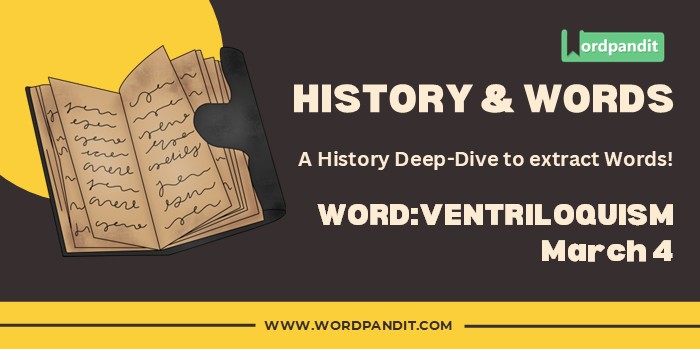History & Words: ‘Ventriloquism’ (March 4)
Welcome to ‘History & Words.’ 🌟 I’m Prashant, founder of Wordpandit and the Learning Inc. Network. This series combines my passion for language learning with historical context. Each entry explores a word’s significance on a specific date, enhancing vocabulary while deepening understanding of history. Join me in this journey of words through time.
📚 Table of Contents
🔍 Word of the Day: Ventriloquism
Pronunciation: /vɛnˈtrɪləkwɪzəm/ (ven-TRIL-uh-kwiz-uhm)
🌍 Introduction
On March 4, 1834, as York was being incorporated as the city of Toronto, William Antonio Hunt, better known as the Great Farini, was born into a world on the cusp of entertainment revolution. His contributions to ventriloquism would help transform this ancient art into a cornerstone of modern entertainment.
Ventriloquism, the art of projecting one’s voice to create the illusion that it comes from elsewhere, represents a fascinating intersection of vocal skill, theatrical performance, and psychological manipulation. While today we associate it primarily with entertainment, its history spans religious practices, cultural traditions, and theatrical arts across multiple continents and centuries.
The convergence of Farini’s birth and Toronto’s incorporation symbolizes a pivotal moment in North American entertainment history, as traditional performing arts began evolving into the modern entertainment industry we know today.
🌱 Etymology
The word “ventriloquism” derives from the Latin words “venter” (belly) and “loqui” (to speak), literally meaning “belly speaking.” This etymology reflects the ancient belief that practitioners spoke from their stomachs rather than their mouths, a misconception that persisted well into the medieval period.
📖 Key Vocabulary
- 🔑 Polyphony: The production of multiple voices or sounds simultaneously, a key skill in ventriloquial arts.
- 🔑 Labial Substitution: The technique of replacing sounds made with the lips (like B, F, M, P, V, W) with similar sounds that don’t require visible lip movement.
- 🔑 Throwing Voice: The illusion of making a sound appear to come from a different location, though technically this is impossible and relies on misdirection.
- 🔑 Figure: The preferred term among professional ventriloquists for what the public often calls a “dummy” or puppet.
🏛️ Historical Context
Ventriloquism’s origins trace back to ancient civilizations, where it played a significant role in religious and spiritual practices. In ancient Greece, the Pythian priestesses of Delphi were believed to channel divine voices through ventriloquial techniques. Similar practices appeared in Egyptian temples and among various indigenous cultures worldwide.
During the Middle Ages in Europe, ventriloquism faced persecution as it was often associated with witchcraft and demonic possession. The Catholic Church particularly viewed the practice with suspicion, forcing practitioners to either abandon their art or risk severe consequences.
The 18th and 19th centuries marked a transformation in ventriloquism’s social status, as it shifted from religious and mystical applications to entertainment. This period saw the emergence of professional ventriloquists who performed in theaters, fairs, and vaudeville shows, laying the groundwork for modern ventriloquial entertainment.
⏳ Timeline
- Ancient Times: Ventriloquism used in religious practices across various civilizations
- Middle Ages: Practice faces persecution and goes underground in Europe
- 1753: Sir John Parnell writes first English language book about ventriloquism
- 1834: Birth of the Great Farini (William Antonio Hunt)
- 1880s: Introduction of the sitting ventriloquist with figure format
- 1920s: Golden age of vaudeville features prominent ventriloquists
- 1950s-1960s: Television brings ventriloquism to mass audiences
- Present Day: Revival through talent shows and modern entertainment
🌟 The Day’s Significance
March 4, 1834, marks not only the birth of the Great Farini but also represents a crucial moment in the evolution of North American entertainment. As Toronto was being established as a major urban center, the foundation was being laid for what would become a thriving entertainment industry.
Farini’s contributions to ventriloquism and circus arts helped establish North America as a leading force in popular entertainment. His innovative approaches to performance and technical skill set new standards for ventriloquial arts, influencing generations of performers who followed.
The coincidence of these events – urban development and the birth of a pioneering entertainer – reflects the broader cultural transformation occurring in North America during the 19th century, as cities grew and entertainment became increasingly professionalized and sophisticated.
💬 Quote
“The art of ventriloquism is not in the throwing of the voice, but in the throwing of the imagination.” – Paul Winchell, legendary ventriloquist and voice actor
🔮 Modern Usage and Reflection
Today, ventriloquism continues to evolve through digital media and modern entertainment formats. While traditional stage performances remain popular, ventriloquists have adapted their art for television, social media, and online platforms, reaching new audiences and inspiring young performers.
The principles of ventriloquism have also found applications beyond entertainment, including speech therapy, language education, and cognitive studies of voice perception and audio-visual integration.
🏛️ Legacy
Ventriloquism’s legacy extends beyond entertainment into cultural history, technological innovation, and psychological understanding. The art form has contributed to our understanding of human perception, voice production, and the power of illusion.
The techniques developed through centuries of ventriloquial practice have influenced voice acting, animation, and digital voice synthesis, demonstrating the enduring impact of this ancient art form on modern media and communication.
🔍 Comparative Analysis
While early ventriloquism focused on religious and mystical applications, modern practice emphasizes entertainment and artistic expression. This transformation reflects broader societal changes in how we understand and appreciate performance arts, moving from spiritual significance to cultural entertainment and educational value.
💡 Did You Know?
🎓 Conclusion
Ventriloquism’s journey from ancient religious practice to modern entertainment art form mirrors broader cultural and social transformations throughout history. The coincidence of the Great Farini’s birth with Toronto’s incorporation symbolizes the modernization of entertainment arts in North America, while the continued evolution of ventriloquism demonstrates the adaptability and enduring appeal of this unique form of expression.
📚 Further Reading
- 📘 “Dumbstruck: A Cultural History of Ventriloquism” by Steven Connor
- 📗 “The Great Farini: The High-Wire Life of William Hunt” by Shane Peacock
- 📙 “Ventriloquism: Art, Craft, Profession” by Paul Winchell












